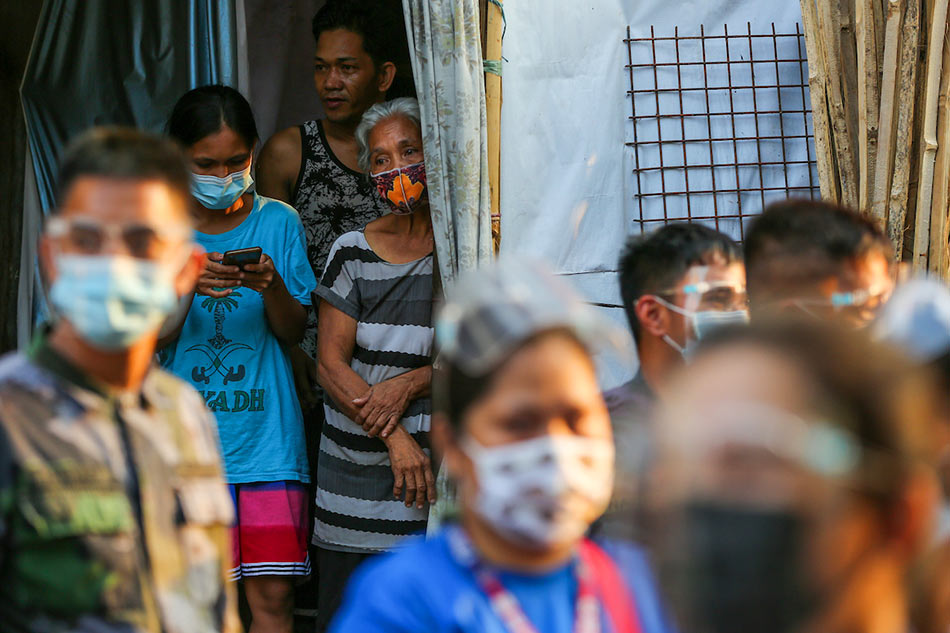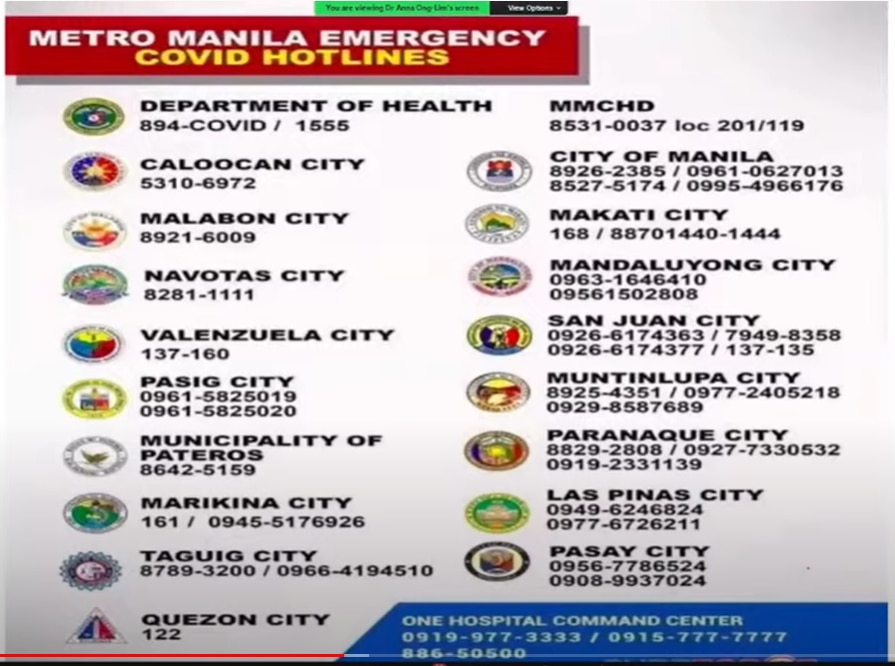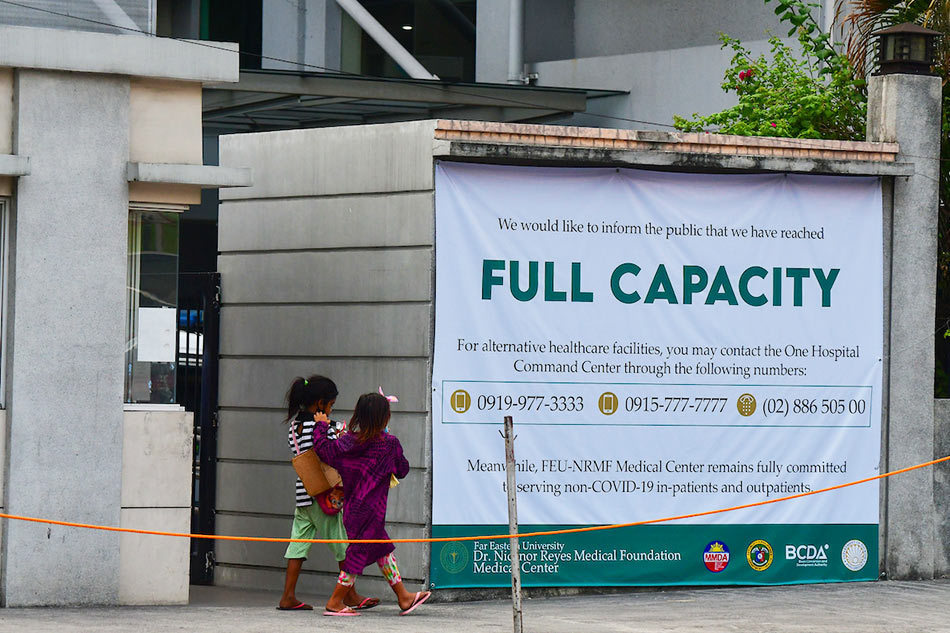Who are qualified, not recommended for COVID-19 home care? Expert gives do's, don'ts | ABS-CBN

Welcome, Kapamilya! We use cookies to improve your browsing experience. Continuing to use this site means you agree to our use of cookies. Tell me more!
Who are qualified, not recommended for COVID-19 home care? Expert gives do's, don'ts
Who are qualified, not recommended for COVID-19 home care? Expert gives do's, don'ts
Job Manahan,
ABS-CBN News
Published Apr 10, 2021 10:32 PM PHT
|
Updated Apr 11, 2021 12:11 AM PHT
Here's what you can do to protect yourself, family during COVID-19 isolation at home
Here's what you can do to protect yourself, family during COVID-19 isolation at home
MANILA—As hospitals in Metro Manila and nearby provinces near the breaking point, a health expert has given a few pointers on how the public can help prevent facilities from filling up.
MANILA—As hospitals in Metro Manila and nearby provinces near the breaking point, a health expert has given a few pointers on how the public can help prevent facilities from filling up.
Pediatric infectious disease expert Dr. Anna Ong-Lim said that due to the surge of COVID-19 infections in pandemic epicenter National Capital Region, home care could be considered by a patient, whether an adult or a child, who is confirmed or suspected with mild disease most especially "when inpatient care is unavailable or unsafe."
Pediatric infectious disease expert Dr. Anna Ong-Lim said that due to the surge of COVID-19 infections in pandemic epicenter National Capital Region, home care could be considered by a patient, whether an adult or a child, who is confirmed or suspected with mild disease most especially "when inpatient care is unavailable or unsafe."
Despite this, she said, it is still important to choose the people who would be isolated at home, most especially those who can manage themselves, and this could be done by consulting with a physician or specialist.
Despite this, she said, it is still important to choose the people who would be isolated at home, most especially those who can manage themselves, and this could be done by consulting with a physician or specialist.
Local government units could also be contacted regarding home care, and many hospitals also offer assistive services for home care patients.
Local government units could also be contacted regarding home care, and many hospitals also offer assistive services for home care patients.
ADVERTISEMENT
"[These include] people who won't need anything more than to be fed... and be given supplies for the 10 days or so they are isolated without any need for anybody to provide additional care for them," Lim said in a virtual forum initiated by Santuario de San Antonio Parish and sponsored by the Philippine Government Hospital's (PGH) ministry.
"[These include] people who won't need anything more than to be fed... and be given supplies for the 10 days or so they are isolated without any need for anybody to provide additional care for them," Lim said in a virtual forum initiated by Santuario de San Antonio Parish and sponsored by the Philippine Government Hospital's (PGH) ministry.
Home care, Lim pointed out, might also be considered by virus patients who have been discharged from hospital if necessary, based also on the guidelines set by the World Health Organization (WHO).
Home care, Lim pointed out, might also be considered by virus patients who have been discharged from hospital if necessary, based also on the guidelines set by the World Health Organization (WHO).
"So hopefully, if you implement home care in your family, you actually won't need to do this because all you have to do is to leave stuff at the door and they can just pick it up and tend for themselves," she said.
"So hopefully, if you implement home care in your family, you actually won't need to do this because all you have to do is to leave stuff at the door and they can just pick it up and tend for themselves," she said.
RELATED VIDEO:
According to the expert, the decision whether to isolate or care for an infected person at home depends on the following:
According to the expert, the decision whether to isolate or care for an infected person at home depends on the following:
- Clinical evaluation of the COVID-19 patient
- Evaluation of the home setting
- Ability to monitor the clinical evolution of a person with COVID-19 at home
- No shortness of breath
- No difficulty of breathing
- Respiratory rate is not less than 30 breaths per minute
- Oxygen saturation on room air at least 94 percent
- Clinical evaluation of the COVID-19 patient
- Evaluation of the home setting
- Ability to monitor the clinical evolution of a person with COVID-19 at home
- No shortness of breath
- No difficulty of breathing
- Respiratory rate is not less than 30 breaths per minute
- Oxygen saturation on room air at least 94 percent
On the other hand, coronavirus patients who do not qualify for home care because of risk factors for severe diseases include the following, based on the WHO's recommendations:
On the other hand, coronavirus patients who do not qualify for home care because of risk factors for severe diseases include the following, based on the WHO's recommendations:
- Patients who are above 60 years old
- Patients who are smokers and who are obese
- Patients who also have noncommunicable diseases such as cardiovascular disease, diabetes, chronic lung disease, chronic kidney disease, immunosuppression
- Patients who have cancer
- Patients who are above 60 years old
- Patients who are smokers and who are obese
- Patients who also have noncommunicable diseases such as cardiovascular disease, diabetes, chronic lung disease, chronic kidney disease, immunosuppression
- Patients who have cancer
She added that patients who are asymptomatic, with mild or moderate disease but do not have the risk factors listed above might not require hospitalization, and home isolation could be viable if the conditions for it were fulfilled.
She added that patients who are asymptomatic, with mild or moderate disease but do not have the risk factors listed above might not require hospitalization, and home isolation could be viable if the conditions for it were fulfilled.
This includes, she said, conditions for implementing appropriate infection, prevention, and control measures (IPC) as well as the feasibility of monitoring by a health worker.
This includes, she said, conditions for implementing appropriate infection, prevention, and control measures (IPC) as well as the feasibility of monitoring by a health worker.
Hospitals in the capital region continue to be overwhelmed with fresh COVID-19 admissions, despite nearly two weeks since the enhanced community quarantine (ECQ) was imposed in the region and nearby provinces of Rizal, Laguna, Cavite, and Bulacan.
Hospitals in the capital region continue to be overwhelmed with fresh COVID-19 admissions, despite nearly two weeks since the enhanced community quarantine (ECQ) was imposed in the region and nearby provinces of Rizal, Laguna, Cavite, and Bulacan.
It also came to the point where the government is distributing modular tents to struggling hospitals and re-deploying health workers from regions where virus transmission rates are low.
It also came to the point where the government is distributing modular tents to struggling hospitals and re-deploying health workers from regions where virus transmission rates are low.
Based on the Department of Health's latest bulletin, 86 percent of some 700 dedicated intensive care units (ICU) in the capital region are already used up, while 69 percent of some 3,800 isolation beds in the region are likewise occupied.
Based on the Department of Health's latest bulletin, 86 percent of some 700 dedicated intensive care units (ICU) in the capital region are already used up, while 69 percent of some 3,800 isolation beds in the region are likewise occupied.
TIPS: Mga dapat gawin kung may magpositibo sa COVID-19 sa bahay
REQUIREMENTS FOR HOME CARE
While in a home care set-up for isolation, the family will still need a separate room and a separate bathroom so isolation can be implemented properly.
While in a home care set-up for isolation, the family will still need a separate room and a separate bathroom so isolation can be implemented properly.
A person who will be caring for the patient should be in proper PPE gear, if possible, but non-contact on the infected person is still important, according to Lim.
A person who will be caring for the patient should be in proper PPE gear, if possible, but non-contact on the infected person is still important, according to Lim.
"This may be in exaggerated implementation because in most cases, we only... recommend for the carer should be wearing a mask and perhaps a shield without any more outfits, however, if [PPE] is available then this can be helpful as well so we can contain the spread," she said.
"This may be in exaggerated implementation because in most cases, we only... recommend for the carer should be wearing a mask and perhaps a shield without any more outfits, however, if [PPE] is available then this can be helpful as well so we can contain the spread," she said.
Aside from separate rooms, the following will be needed in home isolation so it can be implemented properly:
Aside from separate rooms, the following will be needed in home isolation so it can be implemented properly:
- Good air flow in the room where the patient will be staying.
- Closing the door so you contain the person properly and you direct the air flow properly
- Delivery system for the daily needs of that individual without a lot of contact between the people of the household and the isolated individual
- Good air flow in the room where the patient will be staying.
- Closing the door so you contain the person properly and you direct the air flow properly
- Delivery system for the daily needs of that individual without a lot of contact between the people of the household and the isolated individual
Meanwhile, one should seek emergency medical attention if the patient will have trouble breathing, persistent chest pains, new confusion, inability to stay awake, and pale, gray, or blue-colored lips, nail beds, depending on a person's skin tone.
Meanwhile, one should seek emergency medical attention if the patient will have trouble breathing, persistent chest pains, new confusion, inability to stay awake, and pale, gray, or blue-colored lips, nail beds, depending on a person's skin tone.
These could be associated with a person's decreasing oxygen levels in the body, she said.
These could be associated with a person's decreasing oxygen levels in the body, she said.
ISOLATION VS QUARANTINE
Lim, who is also part of the DOH's technical working group, pointed out the difference of isolation and quarantine, as both could be interchanged.
Lim, who is also part of the DOH's technical working group, pointed out the difference of isolation and quarantine, as both could be interchanged.
A person in isolation, she said, is positive for COVID-19 who is needed to be separated from the individual's family members and close contacts to prevent the spread of the disease and to allow fast recovery.
A person in isolation, she said, is positive for COVID-19 who is needed to be separated from the individual's family members and close contacts to prevent the spread of the disease and to allow fast recovery.
"The goal is to stay home at least 10 days have passed and the patient should also have had no more fever and resolved symptoms for at least 3 days after they were discharged," she explained.
"The goal is to stay home at least 10 days have passed and the patient should also have had no more fever and resolved symptoms for at least 3 days after they were discharged," she explained.
On the other hand, a person who is in quarantine needs observation for at least 14 days because they came into close contact with another person positive for the virus.
On the other hand, a person who is in quarantine needs observation for at least 14 days because they came into close contact with another person positive for the virus.
This allows everyone to expect whether symptoms will develop within the observation period.
This allows everyone to expect whether symptoms will develop within the observation period.
"The reason why we want to do that is because people can be contagious even before they test positive or even before they start having symptoms," she emphasized.
"The reason why we want to do that is because people can be contagious even before they test positive or even before they start having symptoms," she emphasized.
"So for those close contacts of a positive case, you may want to happen for that person to stay home for 14 days since the last contact and for those people to watch their symptoms."
"So for those close contacts of a positive case, you may want to happen for that person to stay home for 14 days since the last contact and for those people to watch their symptoms."
For the past week the country has been reporting record-high cases and deaths.
For the past week the country has been reporting record-high cases and deaths.
The Philippines earlier in the day recorded 12,674 more COVID-19 cases, the country's second-highest single day tally so far, with active cases reaching an all-time high 190,000.
The Philippines earlier in the day recorded 12,674 more COVID-19 cases, the country's second-highest single day tally so far, with active cases reaching an all-time high 190,000.
The day's figure pushed the country's cumulative tally to 853,209.
The day's figure pushed the country's cumulative tally to 853,209.
Read More:
Hospitals
home care
home isolation
isolation
quarantine
home quarantine
Anna Ong-Lim
Philippine General Hospital
PGH
Metro Manila hospitals
ADVERTISEMENT
ADVERTISEMENT





